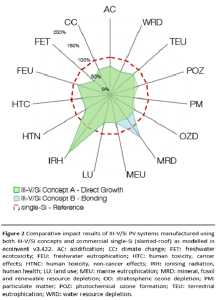Update 1 - Detailed Life Cycle Assessment of III-V/Si modules at lab scale
Description: This work package entailed the development of a detailed model of the lab-scale processes involved in the fabrication of III-V/Si cells, using both direct growth and bonding routes. The model was used as a basis for the calculation of the expected life cycle impacts (LCA) of electricity generation with a III-V/Si PV installation. The aim of the analysis was two-fold; to make a relevant comparison with commercial silicon PV and to identify potential environmental hotspots in the SiTaSol technology. The results were used to guide the project consortium towards more sustainable design choices and to mark key areas for further improvement.
Overall, we found that the enhanced efficiency of III-V/Si cells compensated for the additional processing and material impacts, making them competitive with conventional silicon from an environmental perspective. The main area for improvement we identified was the energy consumption of MOVPE, which can significantly decrease with the higher throughput required for industrial-scale production. From an LCA perspective, no toxicity hotspots were identified in relation to the use of III-V materials; the relevant toxicity impacts mostly came from the copper components required in all PV electrical installations, and the coal-based fraction of the electricity grid in Europe.
In terms of critical materials and resource depletion, indium and gallium consumed in the cell’s III-V layer did not present an area of concern. However, the use of indium required for spray pyrolysis in the bonding route did place this manufacturing route at a disadvantage vs. current silicon PV from a resource-depletion perspective.
